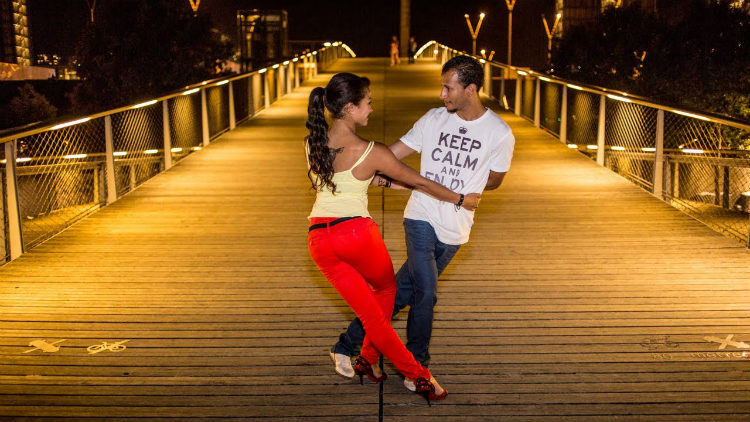Lately, I can’t get enough of kizomba music — the slow, bouncy beat in combination with its dark melodies is purely addictive. Unfortunately, I haven’t tried the dance — mostly because I’ve spent the last year traveling between Portland, Alaska, and Montana, which don’t have as many kizomba opportunities as salsa (if they even have salsa). But I’ve been blasting the same kizomba playlist on Spotify for nearly a year at this point, and I’m really looking forward to trying out the dance one of these days.
Meanwhile, I’ve heard kizomba dancing is sweeping the world. Just by watching YouTube videos, you can tell that the dance is slower and much more sensual than salsa. Kizomba holds more of a “steady shimmer” than a frenetic or fast-paced energy, which can sometimes characterize salsa. And while it may make the dance seem easier, my sources tell me that in fact, the dance can actually be more challenging.
Where does kizomba come from? Here’s my attempt at a run-down:
“Kizomba” means “party” in Kimbundu, one of the languages spoken in Angola, where the dance originates. The dance grew from Semba, another Angolese dance. Kizomba is very similar to Semba, with the difference existing mainly in the music. Kizomba music is influenced by Zouk, which comes from the French Antilles. Later, the dance grew to incorporate movements from the Cuban Son, an influence also found in salsa dancing – as well as Milonga & Tango dances.
Much like salsa, kizomba dance is actually a product of indigenous and European cultures mixing, which unfortunately does tie its existence to colonialism. But rather than look at it as a negative byproduct of that period of history, you could also consider that kizomba dancing — along with all these other types of Latin-inspired and indigenous dances, of which I’m learning there are many — is one way that these indigenous influencers have been able to stay connected to their cultural heritage.
Regardless, the dance certainly continues to reach a wide range of cultures moving forward. During the last five years, kizomba gained popularity in Europe. And recently, it has finally begun to spread in the US.
Can Americans handle such a sensual dance?
So here’s another interesting factoid from the OZY article: according to one of their sources, the dance is more about the connection between the dancers than the performance element — much different from salsa, which has an air of exhibitionism. Indeed, in kizomba, the two dancers face one another closely and move in each others’ arms practically the entire dance.
Maybe this is what’s so intimidating — sharing your body so willingly with someone who is not your romantic partner poses some challenges for Americans. In our culture, personal space is a big deal. We uphold rigid physical boundaries in social environments, especially between men and women.
While in Europe and other parts of the world, where societies tend to allow for more openness regarding sexuality, the human body, and interpersonal contact, we in the US tend to be much more prepared to label different types of physical contact between humans as being either sexual or non-sexual.
Letting go of ingrained boundaries, while staying true to yourself.
So when it comes to kizomba as a dance for the masses, it’s easy to see how difficult this might be for Americans to get used to. Even if you may want to learn the dance, retraining yourself to be able to be physically open with your dance partner may entail consciously forgetting all that society has ever told you about how to protect your personal space.
Bria Sullivan, a kizomba dancer in Boston, brings up the issue of trust in relation to partner dancing. Basically, she says, you have to do a A TON of listening. You have to push your comfort zone — while at the same time, of course, protecting your safety and learning to recognize when you are truly in a situation that makes you feel violated.
All the above being said, kizomba is really starting to catch on in the United States, especially among the younger generation. It has spread to many of the places you would think to be the fastest to adopt the newest trends: NYC, Boston, San Francisco, Miami Beach, and anywhere with enough diversity and enough adventuresome residents to make it happen.
Looking forward to trying it out one of these days, and when I do, I’ll let you know how it went. 🙂


Leave A Reply